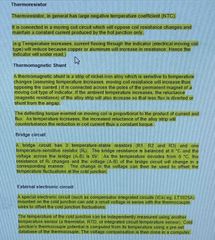![]()
![]()
![]()
Use LEFT and RIGHT arrow keys to navigate between flashcards;
Use UP and DOWN arrow keys to flip the card;
H to show hint;
A reads text to speech;
11 Cards in this Set
- Front
- Back
- 3rd side (hint)
|
Type of tachometer systems |
mechanical indicating type: -centrifugal type -magnetic dry cup type electrical indicating type: - AC type -DC type |
2 main 2 sub for each main |
|
|
4 engine related temp indicators |
- oil temperature gauge - carburettor air temperature gauge - cylinder head temperature gauge - exhaust gas temperature gauge |
|
|
|
stagnation type thermocouple |
gas entry and and exit holes are staggered and of diff sizes. causing gas to slowdown and stagnate at hot junction thus giving it time to respond to changes in temperature |
|
|
|
rapid response type |
sampling holes are diametrical opposite each other and of same size. Gases flow directly over hot junction allowing them to respond more rapidly |
|
|
|
surface contact type thermocouple |
-measure temperature of solid components - temperature sensing element for air cooled engine cylinder head temperature indicating systems |
|
|
|
immersion type |
- measurement of gases - used as sensing element of turbine engine gas temperature indicating systems |
|
|
|
compensation methods within indicator |

- thermoresistor - thermomagnetic shunt - bridge circuit - external electronic device |
theres 4 |
|
|
2 fuel quantity measurement methods |
- float type: controls electrical resistance unit and varies current flow to the indicating element - capacitance type: measure quantity in terms of electrical capacitance and provides highly accurate system of fuel quant. measurement |
|
|
|
capacitance is |
- proportional to area of electrode - inversely proportional to distance separating them - dependent on nature of dielectric or dielectric constant |
|
|
|
angle of attack |
angle btwn chord line of a wing and direction of relative airflow determines magnitude of lift generated by wing As AoA increases lift increases up to certain critical value aft which it decreases. This is because of separation of slow moving air from upper wing surface that causes separation and turbulence on main flow |
|
|
|
what factors determine stall condition |
- wing configuration and whether horizontal stabilised is in the T tail configuration - engine power setting, flap & bank angles, rate of change of pitch |
|

